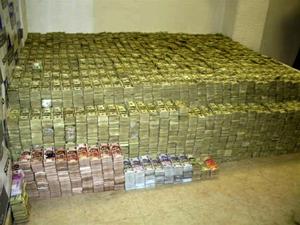Border securityDHS struggles to detect billions in cash smuggled across U.S.-Mexico border
Each year Mexican drug cartels smuggle billions of dollars of cash into and out of the United States, yet despite their best efforts, DHS officials are struggling to stem the flow of cash that is fueling the drug wars; the Department of Justice estimates that each year Mexican drug cartels smuggle as much as $39 billion in cash across the southern border; DHS officials say that it is having a difficult time detecting cash; officials are actively seeking to develop technological solutions to help detect individuals smuggling large amounts of cash across the border; but the technology to accomplish this goals may not exist yet as there are several large technical and logistical hurdles that must be overcome

A captured "cash stash" of mostly U.S. currency // Source: dontbesquare.com
Each year Mexican drug cartels smuggle billions of dollars of cash into and out of the United States, yet despite their best efforts, DHS officials are struggling to stem the flow of cash that is fueling the drug wars.
The Department of Justice estimates that each year Mexican drug cartels smuggle as much as $39 billion in cash across the southern border.
In an attempt to catch currency smugglers, U.S. Customs and Border Patrol launched an “outbound” inspection program in 2009. But, according to the Government Accountability Office, the program only interdicted $67 million in its first two years.
DHS officials say that it is having a difficult time detecting cash.
Current methods include using specially trained dogs and x-ray machines, but these have proven to be ineffective.
Joseph Burke, the chief of the Department of Homeland Security’s Bulk Cash Smuggling Center, explains, “There are a lot of false positives, especially when looking at a vehicle and trying to interpret anomalies and identify cash. Cash is easy to conceal in a small amount of space and it doesn’t show up crystal clear on an X-ray like a weapon would.”
To help combat this problem, DHS officials are actively seeking to develop technological solutions to help detect individuals smuggling large amounts of cash across the border.
Last year the DHS Science and Technology Directorate called on private companies to design “a device that will search for and identify bulk quantities of currency - secreted on persons, in hand baggage and luggage, and/or in privately owned vehicles.”
The agency sought to purchase a non-intrusive detection device that would be capable of screening a person walking with luggage or a slowly-driven vehicle for cash.
Last October, DHS awarded three companies $100,000 to conduct feasibility studies that concluded last week.
DHS is currently reviewing the proposals and will decide if any of the ideas from Lattice Government Services Inc., Intelligent Automation Inc., or Connecticut Analytical Corp are worth investing in.
The agency will come to a conclusion within the next thirty to sixty days, and if a company is chosen it will develop a prototype and begin field-testing.
But it seems that the technology to accomplish its goals may not exist yet as there are several large technical and logistical hurdles that must be overcome.
Paul Burgess, the chief executive of Lattice Inc., explained some of the difficulties that his company faced in developing their concept.
“It isn’t just currency moving through an airport, a body scanner will pick that up. The bigger problem is at border crossings. You can put money in a side door and it’s going to be very difficult to detect,” he said.
In addition, DHS required that the scanners be able to detect U.S. and Canadian dollars as well as euros.
Further complicating detection efforts is the need for speed.
Douglas Farah, a senior fellow with the International Assessment and Strategy Center whostudies detecting large quantities of cash, said that any scanning device that adds too much time to inspections would create unacceptable delays at border crossings.
“Both sides of the border face the same insurmountable obstacle - how to carry out more inspections and become more efficient without damaging the vast amount of legal cargo that rolls through every day. Adding 45 seconds per search per car per day ends up being hundreds of hours in extra waiting time for legal commerce,” Farah said.
Lattice hopes to overcome these challenges by designing a solution that is able to quickly detect cash by relying on electromagnetic, ink-related, or some other factor.
Burgess envisions that the device will resemble a metal detector.
“Ideally, you want a pass or fail scenario. Like a metal detector, either it beeps or it doesn’t beep, that’s where the technology needs to be graduated today,” he said.
While DHS Smuggling Center Chief Burke is enthusiastic about the idea, he remains skeptical that the technology to implement such capabilities is feasible.
He says installing effective currency detection technology would be “a significant step in the right direction.”
But, he added, “The reality is that while that would help, getting from today to that point is a significant challenge.”
